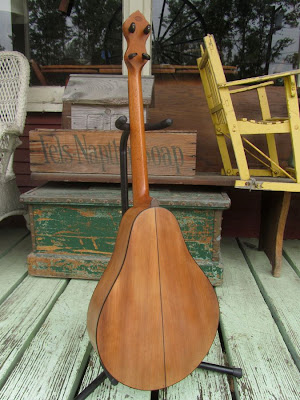c.1925 Lyon & Healy "American Conservatory" Tenor Guitar
Ah, the morning glories have finally come into their own, climbing up to our blue wagon wheel... not bad!
What's under it is even more fun, though. This is a pear-shaped Lyon & Healy tenor guitar, ironically made with pearwood back and sides, from the late 1920s. It's 100% original except for the new (replacement) tenor banjo bridge. Considering the marks near the bridge feet on the top, the original bridge was a 2-footer of much the same size and probably was a banjo bridge of some sort.
...but I'm drifting off course...! This tenor sports a 22 3/4" scale, 11 1/2" wide body, and an extremely lightweight build. It's ladder braced and the bridge sits right in the "sweet spot," so this has amazing volume for its size (with great bite!) and a full-spectrum, balanced sort of tone. It's really saucy for leads. The pearwood back and sides respond more or less like maple so you get great sustain and a clear tone right off the bat.
What's very cool about this, also, is the condition: the only cracks on this are top-layer hairlines on the sides here and there. This is totally not important at all, because like many of the higher-end L&H products (American Conservatory on up), this has laminated sides but a solid back. L&H actually advertised their laminate sides quite heavily, and for good reason: it's more stable and sturdier.
The finish is also nice and clean, too, in its satin look. The only marring is below the soundhole where this was evidently picked a lot.
Bone nut, dyed-hardwood headstock veneer and fretboard. This headstock shape is very familiar to Slingerland banjo owners as well as L&H banjo owners. My hunch is still that Regal built almost all of the instruments (of various types) that bear this headstock shape with the bulk of them having been sold "wholesale" to L&H. Since Regal was sort of owned by L&H at the time, it wouldn't be surprising at all.
Pearl dots, original nickel-silver frets.
My work included a fret level/dress, cleaning, and setup. It's tuned GDAE (octave mandolin) right now and sounds lovely in this range.
It's funny, but these nicer L&H instruments generally need less work than most other makes, from my experience. I guess the nice craftsmanship paid off in the long-run!
Materials: spruce top, pearwood back and sides, dyed fretboard and headstock veneer (probably maple or pearwood, too), and to top it off a nice Spanish cedar (mahogany family, used on a good majority of classical guitars and also throughout the L&H American Conservatory and Washburn lines) neck.
Simple, single-ply bound top and back edges. Nice 3-ring rosette with a multi-ply binding on the inside edge.
Ebony/maple bridge.
This fun tailpiece hinges open rather than sliding off for removing the cover to mount the strings. I have one like this on the "old family mandolin" and I've always liked this design. The rounded edges of the cover make a decent wrist-rest for stand-up play in a pinch, as well.
Good clean label!
The pearwood looks lovely and certainly different. I like the simple, small-sized binding, too. Nice and classy in an understated way.
Pretty stuff! The pear-shaped body is super attractive to me, especially being an octave mandolin fan. The smaller width vs. other "pear-shaped" tenor makers' offerings means it sits very cozily in the lap, too.
L&H patent friction pegs as well as a nice burned-in stamp on the back of the headstock.
One-piece neck looks great!
I haven't decided whether or not to let this one go up on the market, yet. It's such a grandstanding instrument -- loud, with great tone, and the nicer long scale for better projection and string tension. It's also painfully lightweight, so it feels like nothing in the lap. It also has a 12-fret neck which puts the bridge in a comfortable area of the top to play -- not too near the soundhole so that the neck is pushed out far to the left of the player's body. This means less of a stretch and thus less fatigue to play it for extended periods.
Yessir, I'm tempted!



















Comments
Joe
I suppose I should part with it because no one plays it. It's in great shape in the original (but falling apart) case. Contact me if you're interested.
Sharon Skaryd
sharonskaryd@gmail.com